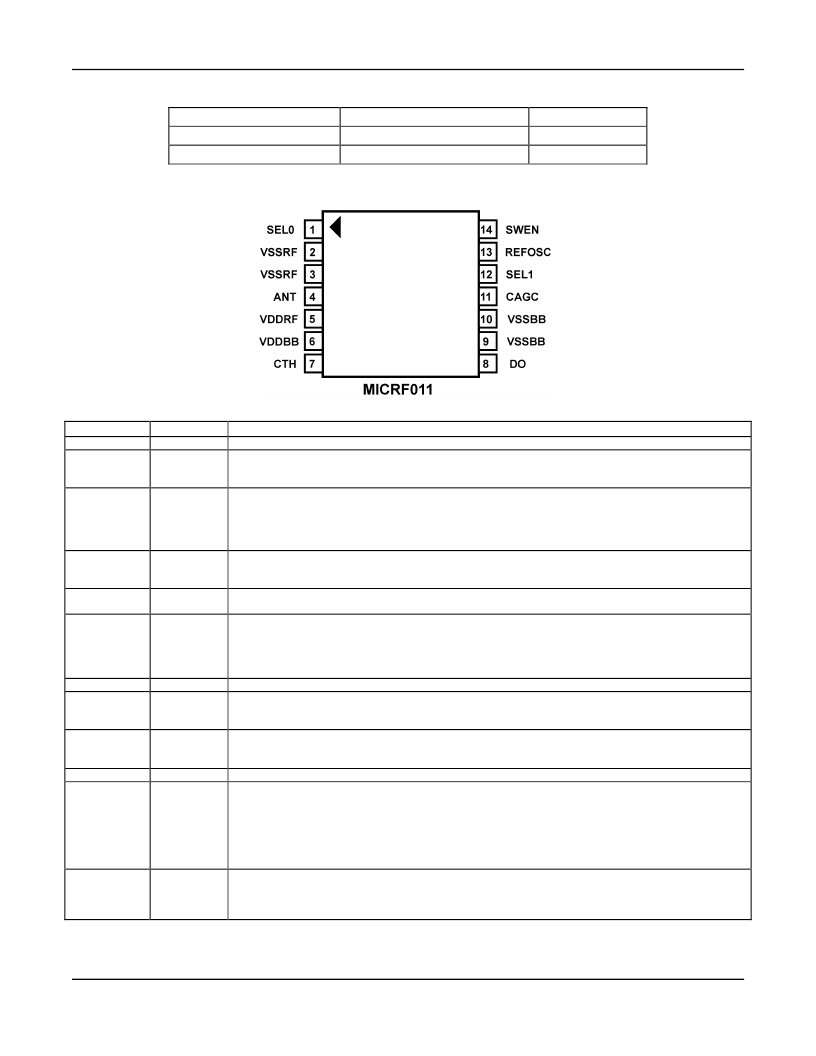- 您现在的位置:买卖IC网 > Sheet目录477 > MICRF011BM TR (Micrel Inc)IC RCVR/DATAMOD300-440MHZ 14SOIC
�� �
�
 �
�MICRF011�
�QwikRadio�
�tm�
�Micrel�
�Ordering� Information�
�Part� Number�
�MICRF011BN�
�MICRF011BM�
�Pin� Configuration� (DIP� and� SOIC)�
�Pin� Description�
�Temperature� Range�
�-40� °� C� to� +85� °� C�
�-40� °� C� to� +85� °� C�
�Package�
�14-Pin� DIP�
�14-Pin� SOIC�
�Pin� Number�
�1�
�2/3�
�4�
�5�
�6�
�7�
�8�
�9/10�
�11�
�12�
�13�
�14�
�Pin� Name�
�SEL0�
�VSSRF�
�ANT�
�VDDRF�
�VDDBB�
�CTH�
�DO�
�VSSBB�
�CAGC�
�SEL1�
�REFOSC�
�SWEN�
�Pin� Function�
�Programs� desired� Demodulator� Filter� Bandwidth.� This� pin� in� internally� pulled-up� to� VDD.� See� Table� 1.�
�This� pin� is� the� ground� return� for� the� RF� section� of� the� IC.� The� bypass� capacitor� connected� from� VDDRF� to�
�VSSRF� should� have� the� shortest� possible� lead� length.� For� best� performance,� connect� VSSRF� to� VSSBB�
�at� the� power� supply� only� (i.e.,� keep� VSSBB� currents� from� flowing� through� VSSRF� return� path).�
�This� is� the� receive� RF� input,� internally� ac-coupled.� Connect� this� pin� to� the� receive� antenna.� Input�
�impedance� is� high� (FET� gate)� with� approximately� 2pF� of� shunt� (parasitic)� capacitance.� For� applications�
�located� in� high� ambient� noise� environments,� a� fixed� value� band-pass� network� may� be� connected� between�
�the� ANT� pin� and� VSSRF� to� provide� additional� receive� selectivity� and� input� overload� protection.� (See�
�“Application� Note� 22,� MICRF001� Theory� of� Operation”� .)�
�This� pin� is� the� positive� supply� input� for� the� RF� section� of� the� IC.� VDDBB� and� VDDRF� should� be� connected�
�directly� at� the� IC� pins.� Connect� a� low� ESL,� low� ESR� decoupling� capacitor� from� this� pin� to� VSSRF,� as� short�
�as� possible.�
�This� pin� is� the� positive� supply� input� for� the� baseband� section� of� the� IC.� VDDBB� and� VDDRF� should� be�
�connected� directly� at� the� IC� pins.�
�This� capacitor� extracts� the� (DC)� average� value� from� the� demodulated� waveform,� which� becomes� the�
�reference� for� the� internal� data� slicing� comparator.� Treat� this� as� a� low-pass� RC� filter� with� source� impedance�
�of� 118kohms� (for� REFOSC� frequency� ft=4.90MHz)� .� Note� that� variation� in� source� resistance� with� filter�
�selection� no� longer� exists,� as� it� does� for� the� MICRF001� .� (See� “Application� Note� 22,� MICRF001� Theory�
�of� Operation”� ,� section� 6.4).� A� standard� ±� 20%� X7R� ceramic� capacitor� is� generally� sufficient.�
�Output� data� pin.� CMOS� level� compatible.�
�This� is� the� ground� return� for� the� baseband� section� of� the� IC.� The� bypass� and� output� capacitors� connected�
�to� VSSBB� should� have� the� shortest� possible� lead� lengths.� For� best� performance,� connect� VSSRF� to�
�VSSBB� at� the� power� supply� only� (i.e.,� keep� VSSBB� currents� from� flowing� through� VSSRF� return� path).�
�Integrating� capacitor� for� on-chip� receive� AGC� (Automatic� Gain� Control).� The� Decay/Attack� time-constant�
�(TC)� ratio� is� nominally� set� as� 10:1.� Use� of� 0.47� μ� F� or� greater� is� strongly� recommended� for� best� range�
�performance.� See� “Application� Note� 22,� MICRF001� Theory� of� Operation”� for� further� information.�
�Programs� desired� Demodulator� Filter� Bandwidth.� This� pin� in� internally� pulled-up� to� VDD.� See� Table� 1.�
�This� is� the� timing� reference� for� on-chip� tuning� and� alignment.� Connect� either� a� ceramic� resonator� or� crystal�
�(mode� dependent)� between� this� pin� and� VSSBB,� or� drive� the� input� with� an� AC� coupled� 0.5Vpp� input� clock.�
�Use� ceramic� resonators� without� integral� capacitors.�
�Note� that� if� operated� in� FIXED� mode,� a� crystal� must� be� used;� however� in� SWP� mode,� one� may� use� either� a�
�crystal� or� ceramic� resonator.� See� “Application� Note� 22,� MICRF001� Theory� of� Operation”� for� details� on�
�frequency� selection� and� accuracy.�
�This� logic� pin� controls� the� operating� mode� of� the� MICRF011.� When� SWEN� =� HIGH,� the� MICRF011� is� in�
�SWP� mode.� This� is� the� normal� (default)� mode� of� the� device.� When� SWEN� =� LOW,� the� device� operates�
�as� a� conventional� single-conversion� superheterodyne� receiver.� (See� “Application� Note� 22,� MICRF001�
�Theory� of� Operation”� for� details.)� This� pin� is� internally� pulled-up� to� VDD.�
�December� 1998b�
�2�
�MICRF011�
�发布紧急采购,3分钟左右您将得到回复。
相关PDF资料
MICRF022YM-FS12
IC RECEIVER ASK 300-440MHZ 8SOIC
MICRF211AYQS TR
IC RCVR 3V 433.92MHZ 16-QSOP
MICRF213AYQS TR
IC RX 3.3V 300-350 MHZ 16QSOP
MICRF218AYQS TR
IC RCVR QWIKRADIO 3.3V 16QSOP
MICRF219AAYQS TR
IC RECEIVER QWIKRADIO 16QSOP
MICRF219AYQS TR
IC RECEIVER QWIKRADIO 16QSOP
MICRF220AYQS TR
RCVR ASK/OOK 300-450MHZ 16QSOP
MICRF221AYQS TR
IC RF RECEIVER QWIKRADIO 16-QSOP
相关代理商/技术参数
MICRF011BN
功能描述:IC RCVR/DATA DEMOD RF/IF 14DIP RoHS:否 类别:RF/IF 和 RFID >> RF 接收器 系列:- 产品培训模块:Lead (SnPb) Finish for COTS 产品变化通告:Product Discontinuation 09/Jan/2012 标准包装:50 系列:* 频率:850MHz ~ 2.175GHz 灵敏度:- 数据传输率 - 最大:- 调制或协议:- 应用:* 电流 - 接收:* 数据接口:PCB,表面贴装 存储容量:- 天线连接器:PCB,表面贴装 特点:- 电源电压:4.75 V ~ 5.25 V 工作温度:0°C ~ 85°C 封装/外壳:40-WFQFN 裸露焊盘 供应商设备封装:40-TQFN-EP(6x6) 包装:托盘
MICRF011YM
功能描述:射频接收器 300-440MHz RF Receiver( Lead Free)
RoHS:否 制造商:Skyworks Solutions, Inc. 类型:GPS Receiver 封装 / 箱体:QFN-24 工作频率:4.092 MHz 工作电源电压:3.3 V 封装:Reel
MICRF011YM TR
功能描述:射频接收器 300-440MHz RF Receiver( Lead Free)
RoHS:否 制造商:Skyworks Solutions, Inc. 类型:GPS Receiver 封装 / 箱体:QFN-24 工作频率:4.092 MHz 工作电源电压:3.3 V 封装:Reel
MICRF011YN
功能描述:射频接收器 300-440MHz RF Receiver( Lead Free)
RoHS:否 制造商:Skyworks Solutions, Inc. 类型:GPS Receiver 封装 / 箱体:QFN-24 工作频率:4.092 MHz 工作电源电压:3.3 V 封装:Reel
MICRF022
制造商:MICREL 制造商全称:Micrel Semiconductor 功能描述:300-440MHz QwikRadio⑩ASK Receiver
MICRF022BM
功能描述:IC RECEIVER ASK 300-440MHZ 8SOIC RoHS:否 类别:RF/IF 和 RFID >> RF 接收器 系列:- 产品培训模块:Lead (SnPb) Finish for COTS 产品变化通告:Product Discontinuation 09/Jan/2012 标准包装:50 系列:* 频率:850MHz ~ 2.175GHz 灵敏度:- 数据传输率 - 最大:- 调制或协议:- 应用:* 电流 - 接收:* 数据接口:PCB,表面贴装 存储容量:- 天线连接器:PCB,表面贴装 特点:- 电源电压:4.75 V ~ 5.25 V 工作温度:0°C ~ 85°C 封装/外壳:40-WFQFN 裸露焊盘 供应商设备封装:40-TQFN-EP(6x6) 包装:托盘
MICRF022BM TR
功能描述:IC RECEIVER ASK 300-440MHZ 8SOIC RoHS:否 类别:RF/IF 和 RFID >> RF 接收器 系列:- 产品培训模块:Lead (SnPb) Finish for COTS 产品变化通告:Product Discontinuation 09/Jan/2012 标准包装:50 系列:* 频率:850MHz ~ 2.175GHz 灵敏度:- 数据传输率 - 最大:- 调制或协议:- 应用:* 电流 - 接收:* 数据接口:PCB,表面贴装 存储容量:- 天线连接器:PCB,表面贴装 特点:- 电源电压:4.75 V ~ 5.25 V 工作温度:0°C ~ 85°C 封装/外壳:40-WFQFN 裸露焊盘 供应商设备封装:40-TQFN-EP(6x6) 包装:托盘
MICRF022BM-FS12
功能描述:IC RECEIVER ASK 300-440MHZ 8SOIC RoHS:否 类别:RF/IF 和 RFID >> RF 接收器 系列:- 产品培训模块:Lead (SnPb) Finish for COTS 产品变化通告:Product Discontinuation 09/Jan/2012 标准包装:50 系列:* 频率:850MHz ~ 2.175GHz 灵敏度:- 数据传输率 - 最大:- 调制或协议:- 应用:* 电流 - 接收:* 数据接口:PCB,表面贴装 存储容量:- 天线连接器:PCB,表面贴装 特点:- 电源电压:4.75 V ~ 5.25 V 工作温度:0°C ~ 85°C 封装/外壳:40-WFQFN 裸露焊盘 供应商设备封装:40-TQFN-EP(6x6) 包装:托盘